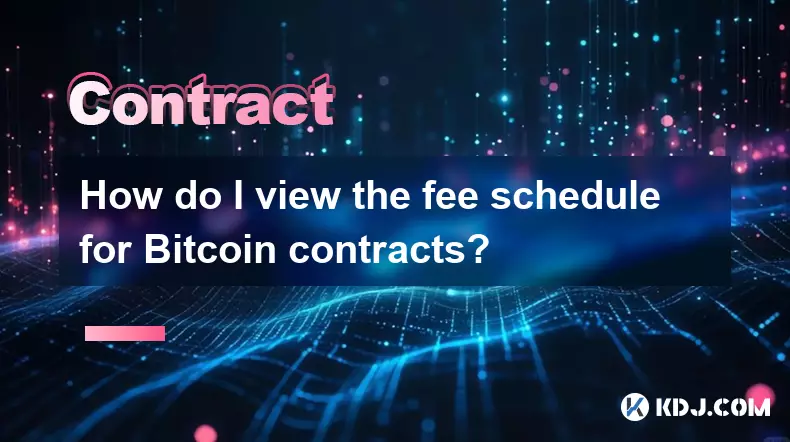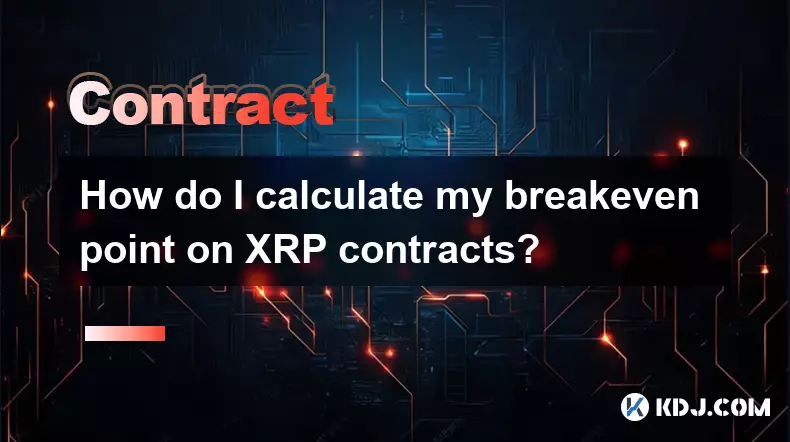-
 bitcoin
bitcoin $121833.232455 USD
-0.63% -
 ethereum
ethereum $4394.437030 USD
-2.00% -
 tether
tether $1.000570 USD
0.04% -
 bnb
bnb $1255.553465 USD
-3.73% -
 xrp
xrp $2.814944 USD
-1.59% -
 solana
solana $221.835346 USD
-2.40% -
 usd-coin
usd-coin $0.999869 USD
0.01% -
 dogecoin
dogecoin $0.249495 USD
-1.32% -
 tron
tron $0.336905 USD
-1.24% -
 cardano
cardano $0.816464 USD
-1.69% -
 chainlink
chainlink $22.130946 USD
-1.27% -
 hyperliquid
hyperliquid $44.208522 USD
-3.46% -
 ethena-usde
ethena-usde $1.000521 USD
0.02% -
 sui
sui $3.422897 USD
-2.51% -
 stellar
stellar $0.380164 USD
-1.31%
How do I view the fee schedule for Bitcoin contracts?
Bitcoin transaction fees vary based on network demand and transaction size, with higher fees prioritizing faster confirmations during congestion.
Sep 25, 2025 at 03:00 am

Understanding Bitcoin Transaction Fees
1. Bitcoin transaction fees are determined by network demand and the size of the transaction in bytes. Users must pay these fees to have their transactions confirmed by miners. The higher the fee, the faster the confirmation time. During periods of high congestion, fees can increase significantly due to competition for block space.
2. To view current fee rates, users can access blockchain explorers such as Blockchain.com or Blockstream.info. These platforms provide real-time data on mempool activity and recommended fees per virtual byte (sat/vB). This information helps users estimate how much they should pay to achieve desired confirmation speeds.
3. Wallet applications often include built-in fee estimators that pull live data from the network. These tools suggest low, medium, and high fee options based on recent block confirmations. Some advanced wallets allow manual fee selection, giving users control over cost versus speed trade-offs.
4. It is essential to understand that fee estimation is dynamic and changes frequently throughout the day. Relying on outdated fee data may result in delayed transactions or overpayment. Monitoring multiple sources ensures more accurate decision-making when setting fees.
Accessing Fee Data Through APIs
1. Developers and traders can retrieve up-to-date fee schedules using public APIs provided by services like BitPay, BlockCypher, or Mempool.space. These APIs return JSON-formatted responses containing current fee recommendations for different confirmation targets (e.g., 1 block, 6 blocks).
2. For example, the Mempool.space API endpoint /api/v1/fees/recommended delivers instant access to fast, half-hour, and economy fee estimates. Integrating this into trading bots or custodial systems allows automated adjustment of transaction costs based on network conditions.
3. Exchange platforms and institutional custody solutions often use internal fee engines that aggregate data from several nodes and APIs. This multi-source approach enhances reliability and reduces dependency on a single provider’s accuracy.
4. APIs enable programmatic access to fee structures, which is crucial for high-frequency operations and algorithmic trading strategies involving Bitcoin transfers. Proper implementation ensures optimal fund movement without unnecessary delays or expenses.
Fee Management in Contract Execution
1. When executing smart contracts or layered protocol interactions on Bitcoin (such as with Ordinals or BRC-20 tokens), transaction size increases due to metadata embedding. This directly impacts fee calculations, requiring careful planning before submission.
2. Tools like Gamma.io or OrdinalsBot offer fee calculators tailored to inscription-based transactions. They break down costs by input count, output count, and payload size, helping users avoid underestimating required fees.
3. Some marketplaces display estimated minting or transfer fees before finalizing actions. These interfaces pull live network data to present realistic cost expectations, reducing failed transactions caused by insufficient fees.
4. Accurate fee forecasting becomes even more critical when dealing with non-standard Bitcoin scripts or multi-signature setups common in institutional custody arrangements. Misjudging fees here can lead to unconfirmed transactions and operational disruptions.
Frequently Asked Questions
What causes sudden spikes in Bitcoin transaction fees?Sudden spikes occur when the number of pending transactions exceeds available block space. Events such as NFT mints, exchange withdrawals after downtime, or macroeconomic news driving trading volume can flood the mempool, forcing users to bid higher fees for priority inclusion.
Can I change the fee after sending a Bitcoin transaction?No, once a transaction is broadcasted, the fee cannot be altered. However, some wallets support Replace-by-Fee (RBF), allowing users to resend the same transaction with a higher fee to replace the original. Not all wallets or services enable RBF by default.
How do I know if my fee is too low?If a transaction remains unconfirmed for several hours during normal network conditions, the fee is likely too low. Checking the transaction ID on a block explorer will show its position in the mempool and estimated confirmation time based on current fee levels.
Are there alternatives to paying high Bitcoin fees?Yes, layer-2 solutions like the Lightning Network allow instant, low-cost payments off-chain while settling final balances on the Bitcoin blockchain. Additionally, scheduling non-urgent transactions during low-traffic periods can reduce costs significantly.
Disclaimer:info@kdj.com
The information provided is not trading advice. kdj.com does not assume any responsibility for any investments made based on the information provided in this article. Cryptocurrencies are highly volatile and it is highly recommended that you invest with caution after thorough research!
If you believe that the content used on this website infringes your copyright, please contact us immediately (info@kdj.com) and we will delete it promptly.
- Avalanche, BLAZ, and Presale Opportunity: Catching the Next Wave in DeFi
- 2025-10-10 18:45:17
- Analyst's Crystal Ball: Will BRETT Mirror PEPE's Moonshot?
- 2025-10-10 18:45:17
- Token Economy, AI Inference, and the New Gold Rush: Decoding the AI Investment Boom
- 2025-10-10 18:50:01
- Dogecoin, Pepe Coin, and Remittix: A New York Minute on Crypto Trends
- 2025-10-10 18:25:14
- Pudgy Penguins Price Prediction: Cup-and-Handle Pattern Hints at Breakout?
- 2025-10-10 18:50:01
- Solana, Ozak AI, and the Crypto Market: Navigating the Hype
- 2025-10-10 18:50:01
Related knowledge

How to calculate the ROI for Ethereum contracts?
Oct 09,2025 at 04:36pm
Understanding Ethereum Contract ROI Basics1. Return on Investment (ROI) for Ethereum contracts begins with tracking the initial capital deployed into ...

How do I calculate my breakeven point on XRP contracts?
Oct 09,2025 at 08:36pm
Understanding the Breakeven Point in XRP Futures TradingCalculating the breakeven point for XRP contracts is essential for traders who engage in futur...

Where can I find historical data for SOL contracts?
Oct 10,2025 at 06:54pm
Accessing Historical Data for SOL Contracts1. Solana blockchain explorers provide comprehensive tools to retrieve historical data related to smart con...

How to place a take-profit order for Dogecoin contracts?
Oct 10,2025 at 05:01am
Understanding Take-Profit Orders in Dogecoin Futures Trading1. A take-profit order is a tool used by traders to automatically close a position when th...

What are the settlement procedures for XRP contracts?
Oct 09,2025 at 04:01pm
Understanding XRP Futures and Derivative Contracts1. XRP derivative contracts are typically offered by cryptocurrency exchanges that support margin tr...

How to reduce trading fees for Bitcoin contracts?
Oct 09,2025 at 02:37pm
Understanding Bitcoin Contract Trading Fees1. Trading fees on Bitcoin contracts are typically charged by exchanges for executing buy and sell orders. ...

How to calculate the ROI for Ethereum contracts?
Oct 09,2025 at 04:36pm
Understanding Ethereum Contract ROI Basics1. Return on Investment (ROI) for Ethereum contracts begins with tracking the initial capital deployed into ...

How do I calculate my breakeven point on XRP contracts?
Oct 09,2025 at 08:36pm
Understanding the Breakeven Point in XRP Futures TradingCalculating the breakeven point for XRP contracts is essential for traders who engage in futur...

Where can I find historical data for SOL contracts?
Oct 10,2025 at 06:54pm
Accessing Historical Data for SOL Contracts1. Solana blockchain explorers provide comprehensive tools to retrieve historical data related to smart con...

How to place a take-profit order for Dogecoin contracts?
Oct 10,2025 at 05:01am
Understanding Take-Profit Orders in Dogecoin Futures Trading1. A take-profit order is a tool used by traders to automatically close a position when th...

What are the settlement procedures for XRP contracts?
Oct 09,2025 at 04:01pm
Understanding XRP Futures and Derivative Contracts1. XRP derivative contracts are typically offered by cryptocurrency exchanges that support margin tr...

How to reduce trading fees for Bitcoin contracts?
Oct 09,2025 at 02:37pm
Understanding Bitcoin Contract Trading Fees1. Trading fees on Bitcoin contracts are typically charged by exchanges for executing buy and sell orders. ...
See all articles

























![Web3 Crypto Market Morning Report: Fomo on the Bnb chain continues, Binance launches the chain-sweeping platform Meme Rush, the market value of Xiuxian exceeds 40 million U.S. dollars, OK Binance business war begins [Vic TALK Issue 1437] Web3 Crypto Market Morning Report: Fomo on the Bnb chain continues, Binance launches the chain-sweeping platform Meme Rush, the market value of Xiuxian exceeds 40 million U.S. dollars, OK Binance business war begins [Vic TALK Issue 1437]](/uploads/2025/10/10/cryptocurrencies-news/videos/web-crypto-market-morning-report-fomo-bnb-chain-continues-binance-launches-chainsweeping-platform-meme-rush-market-xiuxian-exceeds-dollars-binance-business-war-vic-talk-issue/68e861c5dbd1c_image_500_375.webp)
















































